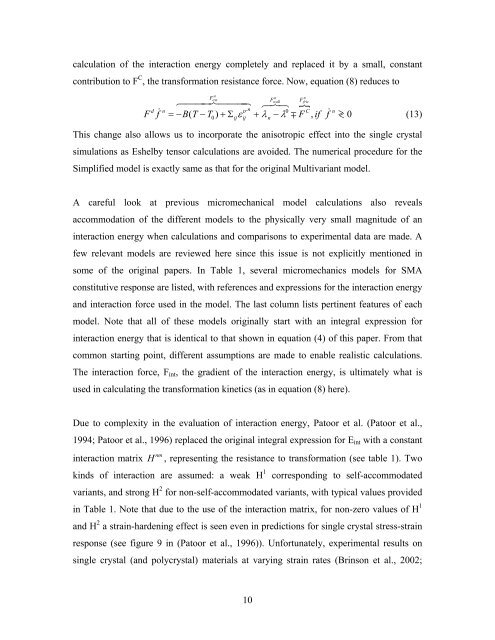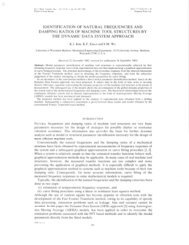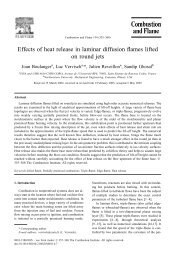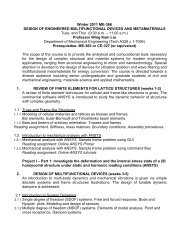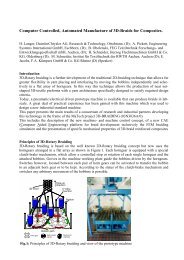A Simplified Multivariant SMA Model Based on Invariant Plane ...
A Simplified Multivariant SMA Model Based on Invariant Plane ...
A Simplified Multivariant SMA Model Based on Invariant Plane ...
You also want an ePaper? Increase the reach of your titles
YUMPU automatically turns print PDFs into web optimized ePapers that Google loves.
calculati<strong>on</strong> of the interacti<strong>on</strong> energy completely and replaced it by a small, c<strong>on</strong>stant<br />
c<strong>on</strong>tributi<strong>on</strong> to F C , the transformati<strong>on</strong> resistance force. Now, equati<strong>on</strong> (8) reduces to<br />
d n<br />
tr<br />
F f B T T F if f<br />
n<br />
Fext<br />
F F<br />
C n<br />
n<br />
n<br />
n<br />
��������� wall<br />
fric ���<br />
� 0<br />
=− ( − ) + Σ ε + λ − λ ∓ , � > < 0<br />
0<br />
ij ij<br />
This change also allows us to incorporate the anisotropic effect into the single crystal<br />
simulati<strong>on</strong>s as Eshelby tensor calculati<strong>on</strong>s are avoided. The numerical procedure for the<br />
<str<strong>on</strong>g>Simplified</str<strong>on</strong>g> model is exactly same as that for the original <str<strong>on</strong>g>Multivariant</str<strong>on</strong>g> model.<br />
A careful look at previous micromechanical model calculati<strong>on</strong>s also reveals<br />
accommodati<strong>on</strong> of the different models to the physically very small magnitude of an<br />
interacti<strong>on</strong> energy when calculati<strong>on</strong>s and comparis<strong>on</strong>s to experimental data are made. A<br />
few relevant models are reviewed here since this issue is not explicitly menti<strong>on</strong>ed in<br />
some of the original papers. In Table 1, several micromechanics models for <str<strong>on</strong>g>SMA</str<strong>on</strong>g><br />
c<strong>on</strong>stitutive resp<strong>on</strong>se are listed, with references and expressi<strong>on</strong>s for the interacti<strong>on</strong> energy<br />
and interacti<strong>on</strong> force used in the model. The last column lists pertinent features of each<br />
model. Note that all of these models originally start with an integral expressi<strong>on</strong> for<br />
interacti<strong>on</strong> energy that is identical to that shown in equati<strong>on</strong> (4) of this paper. From that<br />
comm<strong>on</strong> starting point, different assumpti<strong>on</strong>s are made to enable realistic calculati<strong>on</strong>s.<br />
The interacti<strong>on</strong> force, Fint, the gradient of the interacti<strong>on</strong> energy, is ultimately what is<br />
used in calculating the transformati<strong>on</strong> kinetics (as in equati<strong>on</strong> (8) here).<br />
Due to complexity in the evaluati<strong>on</strong> of interacti<strong>on</strong> energy, Patoor et al. (Patoor et al.,<br />
1994; Patoor et al., 1996) replaced the original integral expressi<strong>on</strong> for Eint with a c<strong>on</strong>stant<br />
interacti<strong>on</strong> matrix H nm , representing the resistance to transformati<strong>on</strong> (see table 1). Two<br />
kinds of interacti<strong>on</strong> are assumed: a weak H 1 corresp<strong>on</strong>ding to self-accommodated<br />
variants, and str<strong>on</strong>g H 2 for n<strong>on</strong>-self-accommodated variants, with typical values provided<br />
in Table 1. Note that due to the use of the interacti<strong>on</strong> matrix, for n<strong>on</strong>-zero values of H 1<br />
and H 2 a strain-hardening effect is seen even in predicti<strong>on</strong>s for single crystal stress-strain<br />
resp<strong>on</strong>se (see figure 9 in (Patoor et al., 1996)). Unfortunately, experimental results <strong>on</strong><br />
single crystal (and polycrystal) materials at varying strain rates (Brins<strong>on</strong> et al., 2002;<br />
10<br />
n<br />
6<br />
(13)


